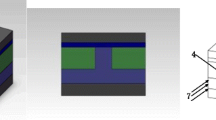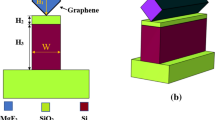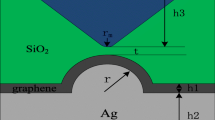Abstract
The two-dimensional material, represented by graphene, is an immediate research focus of interdisciplinary fields, such as nanophotonics and life sciences. The unique advantages of surface plasmon polaritons, such as enhanced transmission and sub-wavelength structure, bring opportunities for achieving all optical circuits. In this paper, based on graphene, silicon dioxide, air cavity, and so on, a novel channel surface plasma waveguide was developed. By contrasting the waveguide characteristics of graphene and gold, it is found that the mode field could be restricted in air cavity region using graphene, and the deep sub-wavelength of light field was restrained. Besides, through finite element simulation, it is investigated that propagation losses could be as low as 0.019 dB/μm, the area of normalized mode field could be as low as 0.014 λ2, and the limiting factor is 0.5. Compared with the current waveguide, the above result shows that the propagation losses is an order of magnitude lower; 20.52% of limiting factor is promoted, besides; better waveguide characteristics could be obtained with realization of sub-wavelength optical field limit. Meanwhile, the production process of waveguide structure is simple, and it is an important way to solve the high speed and miniaturization and integration of optoelectronic integrated technology in the future.






Similar content being viewed by others
References
Dionne JA, Sweatlock LA, Atwater HA, Polman A (2006) Plasmon slot waveguides: towards chip-scale propagation with subwavelength-scale localization. Phys Rev B 73(3):035407
Holmgaard T, Bozhevolnyi SI (2007) Theoretical analysis of dielectric-loaded surface plasmon-polariton waveguides. Phys Rev B 75:245405
Holmgaard T, Gosciniakand J, Bozhevolnyi SI (2010) Long-range dielectric-loaded surface plasmon-polariton waveguides. Opt Express 18(22):23009–23015
Oulton RF, Sorger VJ, Genov DA, Pile DFP, Zhang X (2008) A hybrid plasmonic waveguide for subwavelength confinement and long range propagation. Nat Photonics 2(8):496–500
Liu JT, Xu BZ, Zhang J (2012) Gain-assisted indented plasmonic waveguide for low-threshold nanolaser applications. Chinese. Phys B 21(10):424–428
Magno G, Grande M, Petruzzelli V et al (2013) Asymmetric hybrid double dielectric loaded plasmonic waveguides for sensing applications. Sensors Actuators B Chem 186(186):148–155
J M, Chen L, Li X, Huang WP (2013) Hybrid nano ridge plasmonic polaritons waveguides. Appl Phys Lett 103(13):131107–131107–4
Olyaeefar B, Khoshsima H, Khorram S (2015) Inverse-rib hybrid plasmonic waveguide for low-loss deep sub-wavelength surface plasmon polariton propagation. Opt Quant Electron 47(7):1791–1800
S Wang XY, Wang B, Li et al (2017) Unusual scaling laws for plasmonic nanolasers beyond the diffraction limit. Nat Commun 8(1):1889
Jablan M, Buljan H, Soljacic M (2009) Plasmonics in graphene at infra-red frequencies. Phys Rev B 80(24):245435
Ooi KJA, Chu HS, LK Ang PB (2013) Mid-infrared active graphene nanoribbon plasmonic waveguide devices. J Opt Soc Am B 30(12):3111–3116
Mikhailov SA, Ziegler K (2007) New electromagnetic mode in graphene. Phys Rev Lett 99(1):016803
Sun Y, Bian Y, Zhao X, Zheng Z et al (2013) Low-loss graphene plasmonic waveguide based on a high-index dielectric wedge for tight optical confinement. Lasers Electro-opt 14381182
Lv HB, Liu YM, ZY Y et al (2014) Hybrid plasmonic waveguides for low-threshold nanolaser applications. Chin Opt Lett 12(11):112401
YS Bian Z, Zheng X, Zhao L, Liu J et al (2013) Nanowire based hybrid plasmonic structures for low-threshold lasing at the subwavelength scale. Opt Commun 287:245–249
Sun Y, Zheng Z, Cheng J, Liu J (2014) Graphene surface plasmon waveguides incorporating high-index dielectric ridges for single mode transmission. Opt Commun 328(10):124–128
Funding Sources
This work was supported by Guangxi Natural Science Foundation (2017GXNSFAA198261), National Natural Science Foundation of China (Grant No. 61762018), Guangxi Youth Talent Program (F-KA16016), Innovation Project of Guangxi Graduate Education(XJGY201807, XJGY201811), Guangxi Scholarship Fund of Guangxi Education Department, and Youth Backbone Teacher Growth Support Plan of Guangxi Normal University (Shi Zheng Personnel (2012) 136).
Author information
Authors and Affiliations
Corresponding authors
Rights and permissions
About this article
Cite this article
Wang, G., Zhu, J., Wei, D. et al. Enhanced Air Microcavity of Channel SPP Waveguide HALby Graphene Material. Plasmonics 14, 313–320 (2019). https://doi.org/10.1007/s11468-018-0806-3
Received:
Accepted:
Published:
Issue Date:
DOI: https://doi.org/10.1007/s11468-018-0806-3




